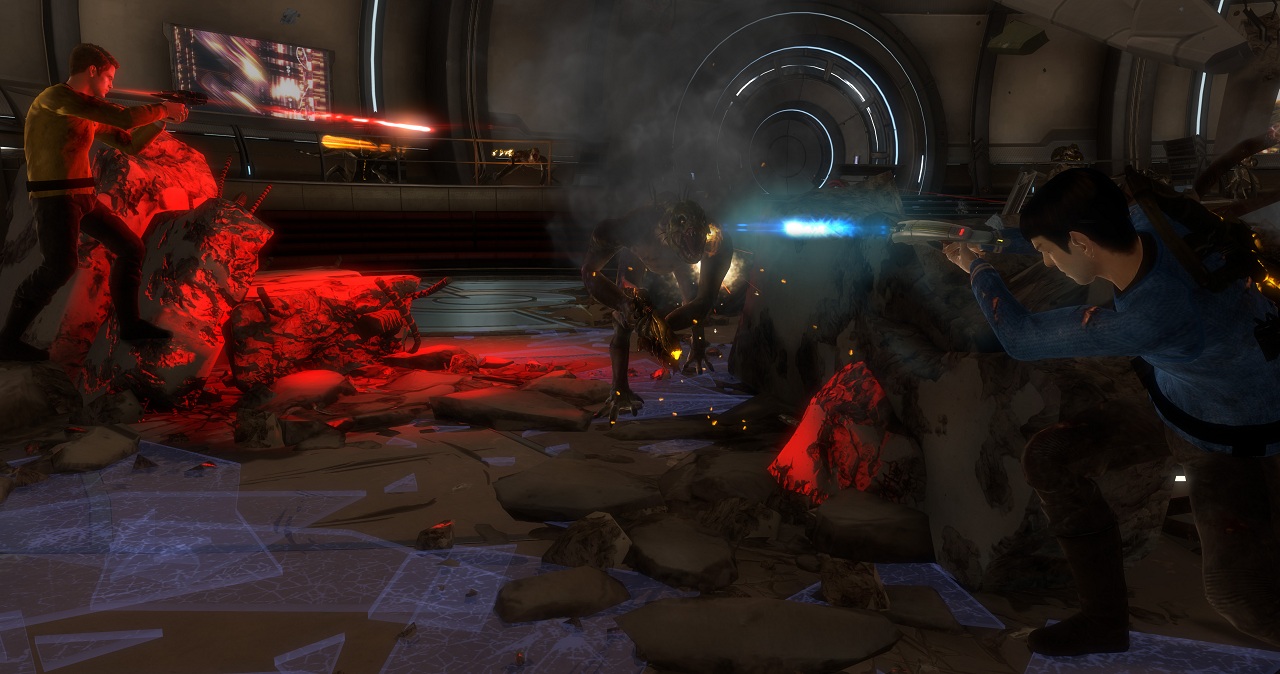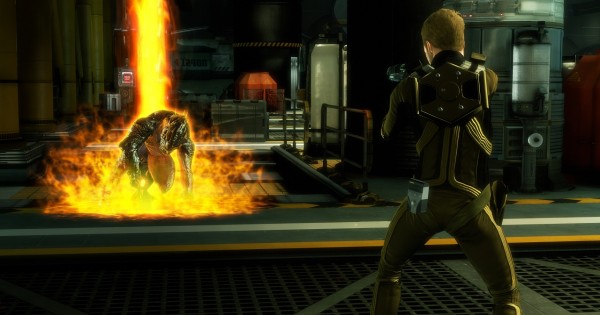
Set for release in PAL regions on April 26th – a day shy of 3 weeks before Paramount Pictures‘ Star Trek Into Darkness – Star Trek: The Video Game actually has little to do with the upcoming sequel, although it is set sometime after the events of the 2009 film. I got some hands-on time with the shooter, and was actually pleasantly surprised, although my expectations were fairly low to begin with.
I got to play an Xbox 360 build that was about 6-8 weeks old. It was mentioned beforehand that because of this fact, the game would be quite buggy, and it was. Hopefully they get ironed out (I’ll mention the more impactful ones throughout the preview). The demo consisted of two full chapters: New Vulcan and Frontier Starbase. They are the 2nd and 3rd chapters in the chronology of the game after the opening on Helios-1 (which I didn’t get to witness). The story centers around a (freshly redesigned) Gorn invasion and attack on the above-mentioned Vulcan home world. Obviously Spock has a vested interest in stopping this and so it’s only apt that the player embodies his character in these early chapters.
Gameplay opened up with a fire-fight wherein Captain Kirk is injured. Shooting my way to him so that I may carry him to a med-bay, I gained a quick understanding of the core mechanics. Star Trek plays like many other shooters out there: you’ve got your Primary and Alternate Fire with the right trigger and shoulder respectively, a quick weapon swap with ‘Y’, reload with ‘X’ and jump with ‘A’. To attach to cover, you must press ‘B’, but to move between cover from that point you must hold the button down when prompted at the spot you wish to move to. Outside of the usage with the cover system, ‘B’ is assigned for a quick roll. Clicking in the left thumbstick and moving in a forward direction enables you to sprint, and simply clicking in the right thumbstick has you enter or exit the “stealth” position – effectively a crouch.
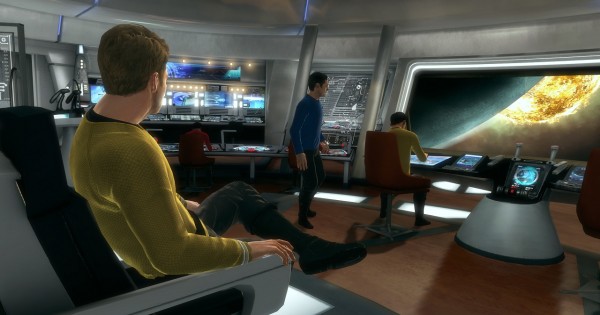
Those are most of the basics of the navigation and combat controls. The first thing I noticed during combat was a lack of feedback when connecting with gunfire. The Gorn would barely react to getting hit unless it was a stun shot or more powerful weapon than the Starfleet Phaser for instance (your starting weapon). Once they were dispatched, I approached Kirk and picked him up by pressing and holding ‘X’, which doubles as the contextual action button. On the way to the med-bay, I gain control of Kirk’s phaser while transporting him to the operation table (I’m sure it has another name, but I’m not a Trekkie…sorry) to fend off more Gorn ambushers. Once he is healed, we continue on in what I expect to be a fruitful human and A.I. co-op partnership…
But, it wasn’t. Kirk stands around…and does nothing. Not all the time mind you, but sometimes, even if an enemy is behind him, he would be static. It was a tad frustrating, and I’m not expecting the best A.I. support come full release, but this game was meant to be enjoyed with human co-op. The same issues were experienced when the first Army of Two was released, and it could definitely have the potential to stifle your progression in single-player depending on the difficulty of a given struggle. Nonetheless, we continue through to the opposite side of the building and not without further opposition. Eventually, after making our way outside, we get bombarded by Gorns beaming down from their attack ships. It’s here that I actually experimented with picking up enemy weapons and using their alternate fire modes.
Firstly, you can manually select your weapon by using the D-Pad, with slots for one rifle, one handgun, one grenade and one special weapon. There is a sort of Gorn rifle that shoots what appears to be a concentrated blast of the very same venom that they poison others with (even cause hallucinations with apparently). It seemed like every gun’s alternate was a form of stun attack that knocked the Gorn down on their backside, from where they could still fire but are most vulnerable and immobile. A similar situation can occur for the player, as when you are badly hurt you are knocked to the ground with your heartbeat audible and the screen fading, waiting for your co-op partner to come and revive you. You can also shoot from this position, but unlike the Gorn, you can drag yourself around as well. Likewise for when your partner is hurt, you will be relied upon to revive them.
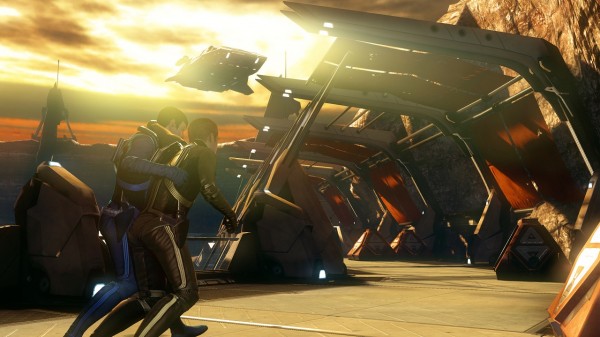
Reviving your buddy involves initiating a kind of mini-game where a wheel appears center screen with button prompts at every quarter point, like a clock face with markings for every 15 minutes. When the bar hits each point, you must hit the correlating button. You can choose to only hit one and not wait to reach the others, but this will only result in a quarter of your friend’s health returning, and so on and so forth. It’s a nice twist on the revival mechanic that has you analyse the situation and wager your time (and your partner’s life) against the immediate threats surrounding you. Clearing the space for evacuation (or “energizing”), we escape the war-zone and enter a cut-scene on board the Enterprise.
This leads into a space-battle segment that felt very rough. Your perspective shifts to the outside of the Enterprise with large enemy ships in full view ahead. You must destroy oncoming attackers, and can even execute slow-mo targeting system that – when successfully utilised – results in a mini-cut-scene of your destructive powers at work. You have a shield meter on the bottom left of the screen as well as the ability to manually activate said shields by pressing and holding ‘LB’ for the desired period of time. Whilst shielded, you cannot shoot, so it’s an issue of strategic timing. The biggest problem I had here is the lack of perceived motion; it felt like the U.S.S. Enterprise was at a stand-still the whole time when it was apparently advancing. Also, the game could do more in the way of visually guiding the player, at times, to the position of the attackable enemy vessels.
Once I had sufficiently dismantled of the Gorn fleet, we beam down to the Frontier Starbase to pay a visit to Commodore Daniels and discuss this invasion, how it started and how it can be stopped. Of course, things go pear shaped rather quickly. This chapter is much more versatile in regards to the gameplay elements found within. Among the inclusion of varied classes of the Gorn species and their pet-like attack drones, turrets, mines, further mini-games, secondary/optional objectives and stealth sections are introduced. Proceeding through the infested labs cannot be achieved without effective use of the Tricorder. The Tricorder – mapped to ‘LB’ – allows you to scan objects and life-forms, hack technology, see enemies patrolling through walls and order your partner into positions, to attack a specified enemy or perform specific tasks that you would otherwise do, allowing you to have his back instead of vice versa.
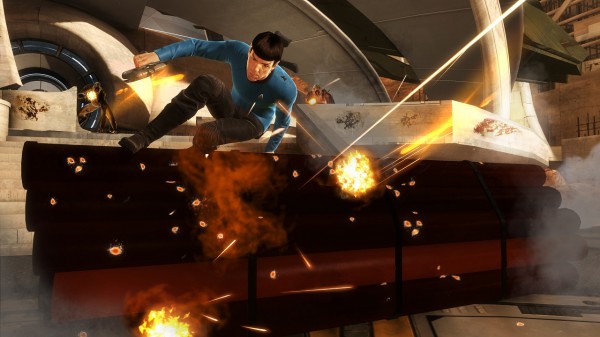
The scanning of lifeforms and weapons adds an entry in your database, which can be accessed via the pause menu. Categories are broken up across the levels, alongside dedicated enemy and weapons pages. This is also where you will be able to listen to acquired audio logs throughout your play through. While I was in the menu system, I decided to press the ‘back’ button which brought me to the upgrades menu. All types of weapons and tech had three possible upgrades which can be purchased with your accrued XP points. I did not delve into the upgrades for my play through, although it probably would have been particularly advantageous as I got rather stuck in a later section of the chapter. Returning to gameplay, I should also mention ammo and health refill stations are scattered throughout the levels, with the ammo refills affecting all guns carried.
The stealth sections I touched upon are directly tied into your optional objective, which may be, for instance, “Reach the mess hall without aggravating the Gorn”…okay, that’s not a real one, but they were similarly worded. The benefit of actually tackling these is that you gain a considerable amount of XP, which, again, can be used for upgrading. Not alerting the Gorn can become tricky business however, as their flying attack drones’ vision is not hindered by any sort of restricted movement like a bipedal. And then there are the mines and turrets. Both can be hacked from a distance, with the latter being linked to a control panel which can be located by following the wires highlighted by the Tricorder. Doing so requires the completion of a mini-game, of which there are two types.
Hacking turrets and other story-centric obstacles such as terminals involve a wavelength matching mini-game, where you are given 8 wavelengths to make 4 matches of using the left and right thumbsticks. Mines are less involved, as they only require you to lead a line to an end point; sort of like the classic mobile game Snake, except with breaks in the grid that must be manoeuvred around. It’s a quicker point ‘a’ to point ‘b’ mini-game. You can also hack the aforementioned attack drones after stunning them and temporarily paralysing them, which happens almost instantaneously without any mini-game. They can become useful allies, but are somewhat easily destroyed. Soon enough, on our way to crawling through vents and preventing the Gorn from overtaking the Starbase, we encounter infected humans which are more inclined to melee attack you. However, you can also take them down with a melee attack, although I found it to be quite a finicky mechanic as the prompt sometimes decides not to show up and allow you to properly defend yourself.
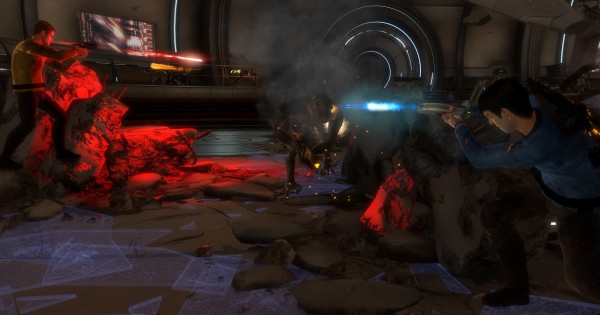
Finally, I had to give up on an entire section where I was tasked with retrieving two data pads, about half way through the chapter. Kirk was no help whatsoever, the enemy numbers seemed endless, and I could only move stealthily up until a point where I could not advance without giving away my position. It was agonizing too, because there was a mine just out of reach of my Tricorder’s hacking range that I felt had to be a mistake…it was positioned within the level design in a way that made me think it was the intended action, but I couldn’t do it without alerting every enemy around. There was also a turret in the far corner of the room whose terminal could not be accessed without entering its line of sight. The space was laid out like a server room, with gaps between every piece of geometry disallowing an easy stealth path, which isn’t even what I want. I just wanted it to be manageable.
All in all, I will say this; excluding all the instances of bugs – A.I. related or otherwise – AND ignoring the seemingly unfinished lip-sync job (I hope it’s not final), Star Trek: The Video Game is actually deeper than I could have ever anticipated. I did not expect the various hacking modules and tactics that go with them. I also saw a good base for fun co-op play. The addition of the likenesses of the main cast from the rebooted films by J.J. Abrams is a nice touch and the story of the game was written in conjunction with the producers of said films, so it has massive potential to enthral and engage Trekkies everywhere. For now, I think some fun can definitely be had with Star Trek: The Video Game – obviously more-so by the franchise’s dedicated fan-base – but I’m holding out hope for the final build to get those tweaks it needs to really refine the experience. We should have a review copy within a fortnight or so…I guess we’ll have to wait until then to find out if that happens.


